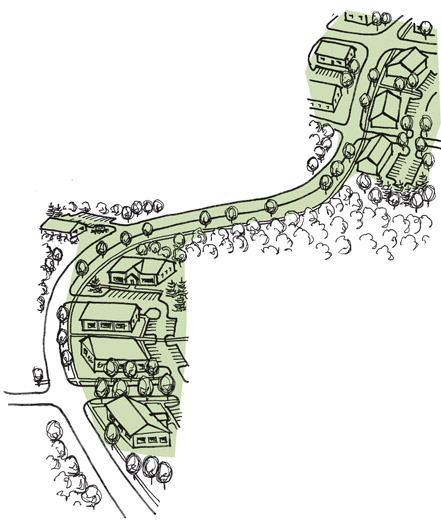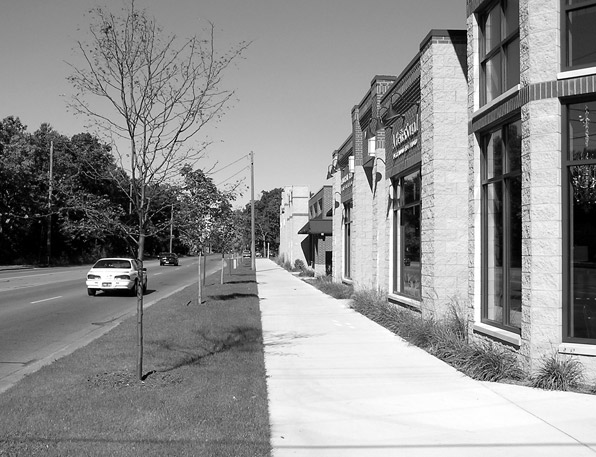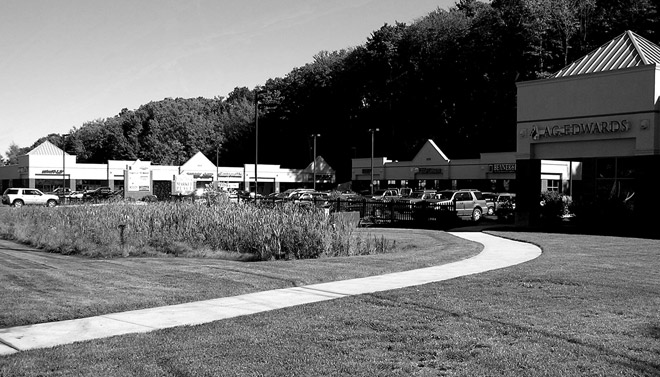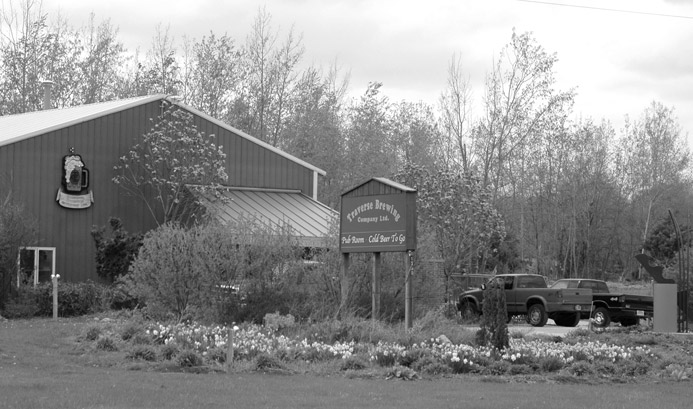|
|
Highway Development is a modification of a traditional downtown development pattern (i.e., businesses lining pedestrian-oriented streets) that can provide valuable retail and office space and complement local community character. Appropriate location and good design is essential to incorporating Highway Developments into the predominantly small-town, rural communities within the five-county region. Highway Developments include a wide range of scales and types, from stand-alone businesses to multi-building complexes, from restaurants and motels to auto dealerships. Retail facilities depend on visibility and accessibility to passing traffic to thrive, so locations along the region’s major roadways will continue to be highly desirable sites for new businesses. Communities that establish site, architectural, and landscaping standards can exert some control and enhance local character through both new and revised Highway Developments.
|
|

|
When Designing Highway Developments:
• Conduct site assessment
• Provide or extend infrastructure
• Locate buildings to retain desirable existing vegetation and other natural features
• Orient buildings to streets and sidewalks
• Incorporate architectural elements to break up building mass
• Provide joint driveways and alternate access
• Design parking areas to facilitate safe and efficient access
• Establish pedestrian pathways connecting building entrances, transit facilities, and parking areas
• Place parking lots behind or beside buildings
• Screen parking areas, especially those between buildings and roadways
• Encourage shared parking and reduced parking standards
• Design landscaped islands to break up the mass of parking areas
• Promote alternative surfacing materials, especially for overflow parking areas
• Establish buffers between Highway Developments and adjacent properties
• Combine and screen service elements
• Use low-maintenance landscaping
• Control and recycle stormwater runoff
• Incorporate context-appropriate signage
• Assess trash and recycling service needs |
 |
Locating Highway Developments
Highway Developments can enhance a community when sited and designed to be an extension of an existing area or an infill project (e.g., Galleries on Garfield on Garfield Avenue in Traverse City). The adaptive reuse of structures and infill projects promote economic and community revitalization in established areas of the region’s communities. To achieve desired development patterns, local jurisdictions should revise master plans and zoning ordinances to direct developments to appropriate locations. Not all property along highway corridors needs to be zoned for commercial use; it may be beneficial to concentrate commercial development more densely at major intersections and retain lower-density, mixed-use agricultural and open space areas in between. Refer to Critical Design Practices: Redevelopment of Existing Properties and Building Revitalization & Reuse for additional information.
|
|

Galleries on Garfield, Traverse City, Grand Traverse County
|
  |
|
Updating Existing Developments
Communities throughout Northwest Lower Michigan enhance local character by requiring existing businesses to apply site design guidelines as land uses change. Although a gradual process, the cumulative effect is an overall improvement of both form and function. Local jurisdictions are encouraged to revise their ordinances to require improvements to structures as uses change, as well as consider the implementation of form-based codes. Additionally, local jurisdictions should allow for the conversion of Highway Developments into medium- and high-density residential developments. Refer to Critical Design Practices: Building Design & Materials and Residential: High-Density Residential for additional information.
|
 |
|
Designing Highway Developments
When a design incorporates attractive architectural and site elements, Highway Developments enhance local and regional character. Using an architectural style reflective of aesthetically pleasing existing structures (e.g., architecture similar to older buildings in a historic area or similar to newer buildings in a newly-developed area) can help integrate Highway Developments into an area by increasing compatibility between new and existing structures. In areas where the current architectural style would benefit from enhancement, local jurisdictions should promote the introduction of an architectural style that will enhance the existing aesthetics over time.
To improve both new and existing Highway Developments, incorporate the following elements: building design and orientation, vehicular and pedestrian access, parking, service elements, signage, lighting, and landscaping. For detailed information on specific techniques, refer to the Critical Design Practices section.
|
|
Building Design & Orientation
Highway Developments should be located near and oriented toward streets as site conditions permit. The design should include visual and architectural elements (e.g., large windows, awnings, signage) to enhance the streetscape. Prominent, well-designed architecture can create focal points along circulation corridors that contribute to local identity and character. Buildings should incorporate designs and materials that are compatible with the surrounding area. When presented with renovation projects, local jurisdictions should encourage rebuilding in a traditional pattern (i.e., buildings close to the street with parking behind). Refer to Critical Design Practices: Building Orientation, Building Compatibility, and Building Design & Materials for additional information.
|
|
|

Landscaping screens parking lot at Grand Traverse Commerce Center, Garfield Township, Grand Traverse County
|
|
Landscaping
Attractive landscaping and site elements can enhance the aesthetic appeal of Highway Developments. Preserving desirable existing vegetation and landscaping with native plants can enhance natural character and reduce maintenance costs. Incompatible land uses, parking lots, and blank walls should be screened and buffered with a mixture of trees, shrubs, and berms. Refer to Critical Design Practices: Landscaping and Streetscape for additional information.
|
|
|

Pedestrian access to Kids Creek Marketplace, Garfield Township, Grand Traverse County
|
|
Access & Circulation
The use of shared roadways and alleys minimizes curb-cuts (i.e., driveways) and provides off-road connectors between businesses for both vehicles and pedestrians. Connections between existing businesses can also improve safety, functionality, and aesthetics. Architectural details and landscaping elements create identifiable, inviting, and accessible entrances. Sidewalks and connections to local and regional trail systems facilitates pedestrian access, which is especially important in more developed areas where more people are likely to use them. Refer to Critical Design Practices: Site Access for additional information.
|
|
|

Screened parking, Traverse Brewing Company, Elk Rapids Township, Antrim County
|
|
Parking
Parking areas should be designed to accommodate site conditions and the needs of businesses while reflecting community character. In higher density areas, on-street parking can provide easy access and minimize surface parking lots. Parking areas should be located behind, beside, or between buildings to minimize the visual impact on adjacent properties. Linking parking areas and providing shared roadway accesses can facilitate ease of access between adjacent properties, increase efficiency in parking areas, and reduce the amount of paved area.
Local jurisdictions should require the buffering and screening of parking lots. When site conditions necessitate parking areas between buildings and roadways, a substantial vegetative buffer can dramatically minimize the visual impact of the parking areas. Bike parking should be provided, especially when developments are or will be connected to a trail network. Refer to Critical Design Practices: Pedestrian & Bike Circulation, Parking, and Landscaping for additional information.
|
|
|

|
|
Streetscape
Streetscape elements (e.g., street trees, site furnishings, special paving) enhance the attractiveness of Highway Developments. Adjacent property owners should be encouraged to work together to create a unified design. Refer to Critical Design Practices: Streetscape for more information.
|
|
|
Lighting & Utilities
Exterior lighting should be designed and scaled to address safety concerns without disturbing adjacent properties or contributing to light pollution. Lights on the sides or rear of buildings should be set on timers or motion sensors so they are on only when needed. Utilities should be installed underground whenever possible. Refer to Critical Design Practices: Site Lighting & Utilities and Streetscape for specific information.
|
|
|
Signage
Signs should be designed to reflect the architectural style and materials of a building, and be sized to be readable without detracting from local character. The appropriate size for a sign will depend on the location of the business. In more urbanized areas, signage should be pedestrian scaled (i.e., small, simple, and easily readable by passers by at slower speeds) and in more rural areas, signs may need to be slightly larger to be visible from more rapidly passing vehicles. Refer to Critical Design Practices: Sign Design & Placement for additional information.
|
|
|
Stormwater Control & Dentention
Keeping parking areas to the minimum necessary and using porous paving reduces the amount of stormwater runoff. Small-scale infiltration elements throughout the site can handle most of the stormwater. Where stormwater detention areas are needed, they should be attractively landscaped and designed to be site amenities. Refer to Critical Design Practices: Stormwater Control & Detention for more information.
|
|
|
Serivce Elements
Service elements (e.g., recycling, dumpsters, loading areas) should be combined whenever possible, as well as located and screened, to minimize impact on adjacent properties and roadways. A site design should provide side or rear delivery and service vehicle access whenever possible. Refer to Critical Design Practices: Service Elements, Site Access, Parking, and Landscaping for additional information.
|
|
|
